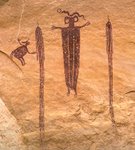Councilor Dorrah says he found more cows in the watershed yesterday, a day after Thursday's Council Work Session where he informed staff and Council that cows were still getting in, but hey, who cares. . . . . After all, Don Foster, the relevant rancher/permittee, assured us in a letter to the editor in the Baker City Herald on August 28, 2013 that:
"These are three-wire drift fences designed so game can jump then, but good enough to turn cattle. Maintenance is not the responsibility of the city or the Forest Service. It is the responsibility of the permittee — yours truly — who grazes the cattle. Being responsible for the fence maintenance, as well as the cattle grazing, I can tell you this: The fencing was done. The cattle, during the time of this crypto outbreak, were in the California Gulch pasture. They are now in the Blue Canyon/Auburn area with some that have drifted north to Elk Creek. While three pair did briefly enter the watershed last week below the diversion they were removed quickly since when I got the call I was nearby and horseback. The fence where they entered was fixed immediately. I have what I consider a good relationship with the city water folks. If they see cattle, or signs of cattle, I respond as soon as possible. . . . .My family takes our ranch duties and work seriously."Too bad the city rarely informs the Forest Service of cattle trespass on the watershed, with whom we are told they also have a "good relationship."
The Council work session agenda of August 29, 2013 states under item 3, that the sole purpose was a "Discussion of Council/Staff Relations. I was under the impression that the subject might have something to do with the fact that city staff has seemingly, according to council videos, minutes and personal emails, repeatedly, over a three year period, not reported important facts to the Council, the City Manager, or the public. I thought that their lack of communication within that apparent relationship, including not informing Council and the public for over a year (March 2010 to November 2011) about the fact that crypto had been found in our water, that they had known since at least 2011 that cows were gaining entry into our watershed, that we were supposed to have a fence installed in in the watershed by the spring of 2012, and that City Manager Kee said he didn't know on August 15, 2013 whether cows had been in our watershed, might be a matter of discussion. How wrong I was!
Thankfully, Councilor Dennid Dorrah stepped up at the beginning of the meeting to tell Council that during his visits to the watershed over the last week, cows were still in the watershed, in the pasture they were not scheduled to be in, and that the fence to keep them out was in deplorable condition. He actually went up there with his own materials and labor to try to repair the fence during that time to try and keep them out. This after city staff, the Forest Service, and the permittee were informed of the problem!
Here is his presentation, part one:
Councilor Dorrah on Cows He Found In & next to the Watershed 083013
Cows near watershed fence.
There are two cows and two calves outside the watershed fence in this grainy closeup picture. Councilor Dorrah reported that one of the calves was inside the watershed originally, but when he went down to run him out, he charged back to mama who was outside the watershed fence.
Why weren't City Manager Kee, the Councilors, and the citizens of Baker City more aware of the fact that Public Works Department personnel have known about cows getting into the watershed for over two years? Why didn't we know that the Department of Public works told the state Drinking Water Program on November 18, 2011, less than two weeks after we were told about the crypto in our water supply, that:"In order to better protect the Elk Creek Diversion Intake we will be constructing new fence next spring [Spring of 2012--over a year ago] along the boundaries of the city owned 40 acre parcel. The new fencing will prevent any livestock from entering into the city property.
Similarly, why weren't we all, including City Manager Mike Kee, informed early on that the Watershed Management report from March 4, 2013 stated: "Also the City has purchased materials to construct a barb wire fence around 40 acres of City owned land surrounding the Elk Creek Diversion. This fence will provide a barrier for cattle ranging in the close proximity. Currently there is a meandering range allotment fence that extends for miles. This fence protects the Elk Creek Watershed and is in good repair most of the time, but there have been incidents where cattle have found their way to the wrong side of the fence. The new fence will protect the diversion and approximately 1/4 mile ofthe Elk Creek riparian zone from stray cattle." The promised fence was never built. So, given that safe drinking water is of fundamental importance to the healthy functioning and economic prosperity of a city, and given that Public Works knew that cows were regularly trespassing on the watershed around Elk Creek, why wasn't the plan to build that fence in the spring of 2012 followed? I was told by a person at the state level that "the fencing project was not undertaken due to time/manpower limitations." Well, during that time, our resources in time and manpower were being spent on expanding the irrigation pond at the golf course and on Resort Street under-grounding of utilities. (See the Weekly Reports for the period in question.)
[See part 2 here. Part 2--Thoughts about the Council Work Session of August 29, 3013]















No comments:
Post a Comment